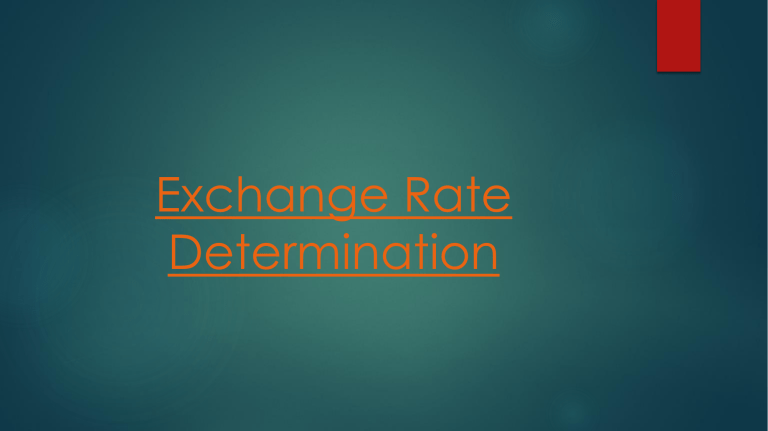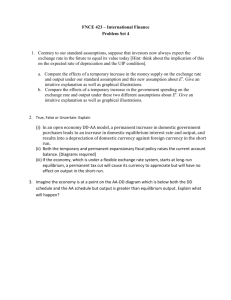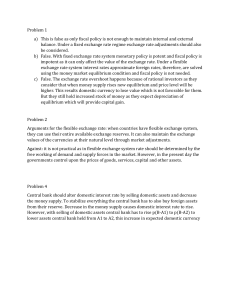
Exchange Rate Determination Key Points To explain how exchange rate movements are measured To explain how the equilibrium exchange rate is determined To examine the factors that affect the equilibrium exchange rate. Measuring Exchange Rate Movements An exchange rate measures the value of one currency in units of another currency. When a currency declines in value, it is said to depreciate. When it increases in value, it is said to appreciate. On the days when some currencies appreciate while others depreciate against the dollar, the dollar is said to be “mixed in trading. Measuring Exchange Rate Movements The percentage change (% ∆) in the value of a foreign currency is computed as 𝑆𝑡 − 𝑆 𝑡 − 1 𝑆𝑡−1 where St denotes the spot rate at time t. A positive % ∆ represents appreciation of the foreign currency, while a negative % ∆ represents depreciation. Exchange Rate Equilibrium An exchange rate represents the price of a currency, which is determined by the demand for that currency relative to the supply for that currency. At any point in time, a currency should exhibit the price at which the demand for that currency is equal to supply, and this represents the equilibrium exchange rate. Exchange Rate Equilibrium Exchange Rate Equilibrium At exchange rates lower than equilibrium, the quantity of pounds demanded would exceed the supply of pounds for sale; consequently, the banks that provide foreign exchange services would experience a shortage of pounds. Conversely, at exchange rates higher than equilibrium, the quantity of pounds supplied would exceed demand; banks would experience a surplus of pounds at this rate. Exchange Rate Equilibrium The liquidity of currency effects the sensitivity of the exchange rate to specific transactions. With many willing buyers and sellers, even large transactions can be easily accommodated. Conversely, illiquid currencies tend to exhibit more volatile exchange rate movements. Factors that Influence Exchange Rates The following equation summarizes the factors that can influence a currency’s spot rate: 1- Relative Inflation Rates U.S. inflation U.S. demand for British goods, and hence £. British desire for U.S. goods, and hence the supply of £. 2- Relative Interest Rates U.S. interest rate U.S. demand for British bank deposits, and hence £. British desire for U.S. bank deposits, and hence the supply of £. 2- Relative Interest Rates A relatively high interest rate may actually reflect expectations of relatively high inflation, which discourages foreign investment. It is thus useful to consider real interest rates, which adjust the nominal interest rates for inflation. 2- Relative Interest Rates Real Interest rate Nominal ≈ Interest - rate This relationship is sometimes called the Fisher effect. Inflation 3- Relative Income Levels U.S. income level increases It increases U.S. demand for British goods, and hence £. No expected change for the supply of £. 4- Government Controls Governments may influence the equilibrium exchange rate by: imposing foreign exchange barriers imposing foreign trade barriers intervening in the foreign exchange market affecting macro variables such as inflation, interest rates, and income levels 5- Expectations Foreign exchange markets react to any news that may have a future effect. News of potential surge in U.S. inflation may cause currency traders to sell dollars. Institutional investors often take currency positions based on anticipated interest rate movements in various countries. Because of speculative transactions, foreign exchange rates can be very volatile. 5- Expectations Economic signals that effect exchange rates can change quickly, such that speculators may overreact initially and then find that they have to make a correction. Speculation on the currencies of emerging markets can have a substantial impact on their exchange rates. Interaction of Factors Trade-related factors and financial factors sometimes interact. Exchange rate movements may be simultaneously affected by these factors. For example, an increase in the level of income sometimes causes expectations of higher interest rates. Interaction of Factors Over a particular period, different factors may place opposing pressures on the value of a foreign currency. The sensitivity of the exchange rate to these factors is dependent on the volume of international transactions between the two countries. How Factors Affect Exchange Rates How Factors Affect Exchange Rates Assume the simultaneous increase of U.S. inflation and U.S. interest rates. Increase in U.S. inflation will place upward pressure on the pound’s value. Increase in the U.S. interest rates will place downward pressure on the pound’s value. The sensitivity of an exchange rate to these factors is dependent on the volume of international transactions between the two countries. How Factors Affect Exchange Rates If the two countries engage in a large volume of trade but very small international capital flows, the relative inflation rates will likely be more influential. If the two countries engage in a large volume of capital flows, interest rate fluctuations may be most influential. How Factors Affect Exchange Rates Because the dollar’s value changes by different magnitudes relative to each foreign currency, analysts often measure the dollar’s strength with an index in which several currencies are consolidated into a single composite. The weight assigned to each currency is determined by its relative importance in international trade and/or finance. Interaction of Factors The sensitivity of an exchange rate to the factors is dependent on the volume of international transactions between the two countries. Large volume of international trade => relative inflation rates may be more influential Large volume of capital flows ⇒ interest rate fluctuations may be more influential Interaction of Factors An understanding of exchange rate equilibrium does not guarantee accurate forecasts of future exchange rates because that will depend in part on how the factors that affect exchange rates will change in the future. Speculating on Anticipated Exchange Rates Many commercial banks attempt to capitalize on their forecasts of anticipated exchange rate movements in the foreign exchange market. The potential returns from foreign currency speculation are high for banks that have large borrowing capacity. The simple strategy is to get out of the currency about to depreciate and into the currency that is going to appreciate against it. Then reverse the positions after the event to end up with more than you started with. Speculating on Anticipated Exchange Rates London Bank expects the exchange rate of the New Zealand dollar to appreciate against the £ from its present level of £0.35 to £0.38 in 30 days. Speculating on Anticipated Exchange Rates London Bank expects the exchange rate of the New Zealand dollar to depreciate from its present level of 0.50 euros to 0.48 euros in 30 days. Speculating on Anticipated Exchange Rates Exchange rates are very volatile, and a poor forecast can result in a large loss. One well-known bank failure, Franklin National Bank in 1974, was primarily attributed to massive speculative losses from foreign currency positions. Thank you!






